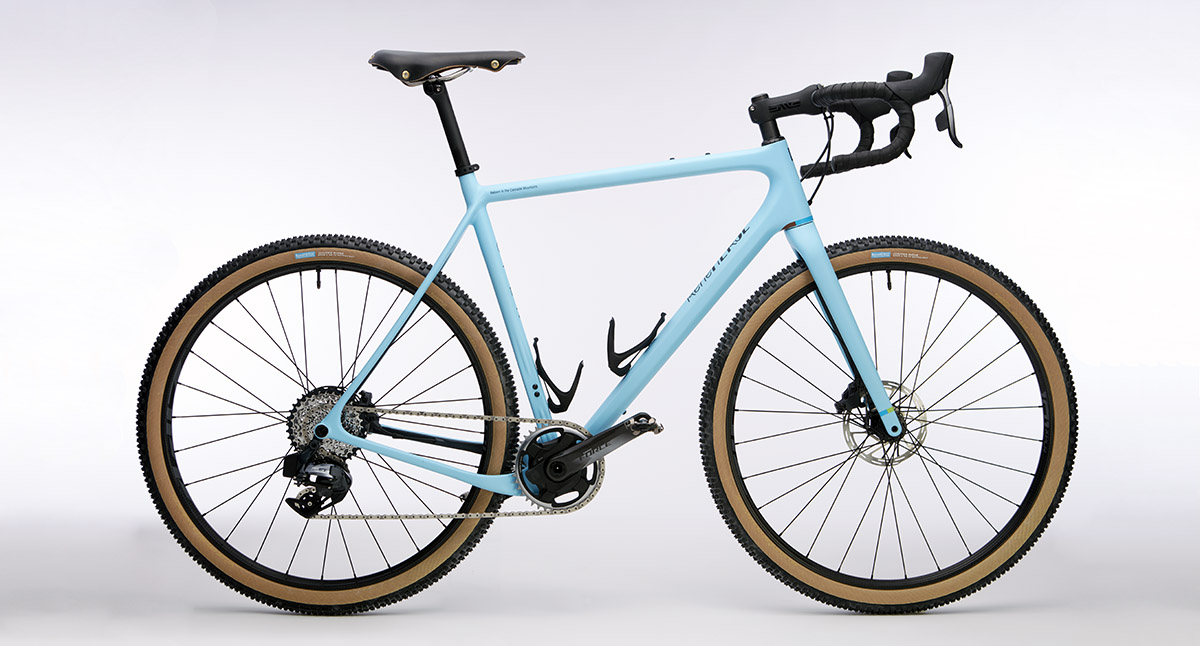The Build of Jan’s OPEN × Rene Herse
A number of readers have asked about the build of my OPEN × Rene Herse U.P.P.E.R., so here it is. The build was informed by the qualities I wanted in this bike. The goal was to bring out the best of the U.P.P.E.R.: I want a bike that is fun to ride and reliable.
There are many great ways to set up a bike. Preferences, riding styles and aesthetics are important considerations when selecting the parts for a build. I have pretty strong opinions about equipment. (After all, I started a company because nobody made the parts I wanted for my riding.) So please take what follows as just one rider’s very personal ideas and preferences.
Components
I opted for a one-by SRAM Force XPLR groupset. For modern drivetrains, I love one-by. I don’t really need more than 12 carefully selected gears, so there’s no need for two chainrings up front—especially with a frame that planes so well that I don’t find myself hunting for that perfect ‘in-between’ gear. I like eTap, because shifting is super-simple: Push the left paddle for a smaller gear, the right paddle for a larger gear.
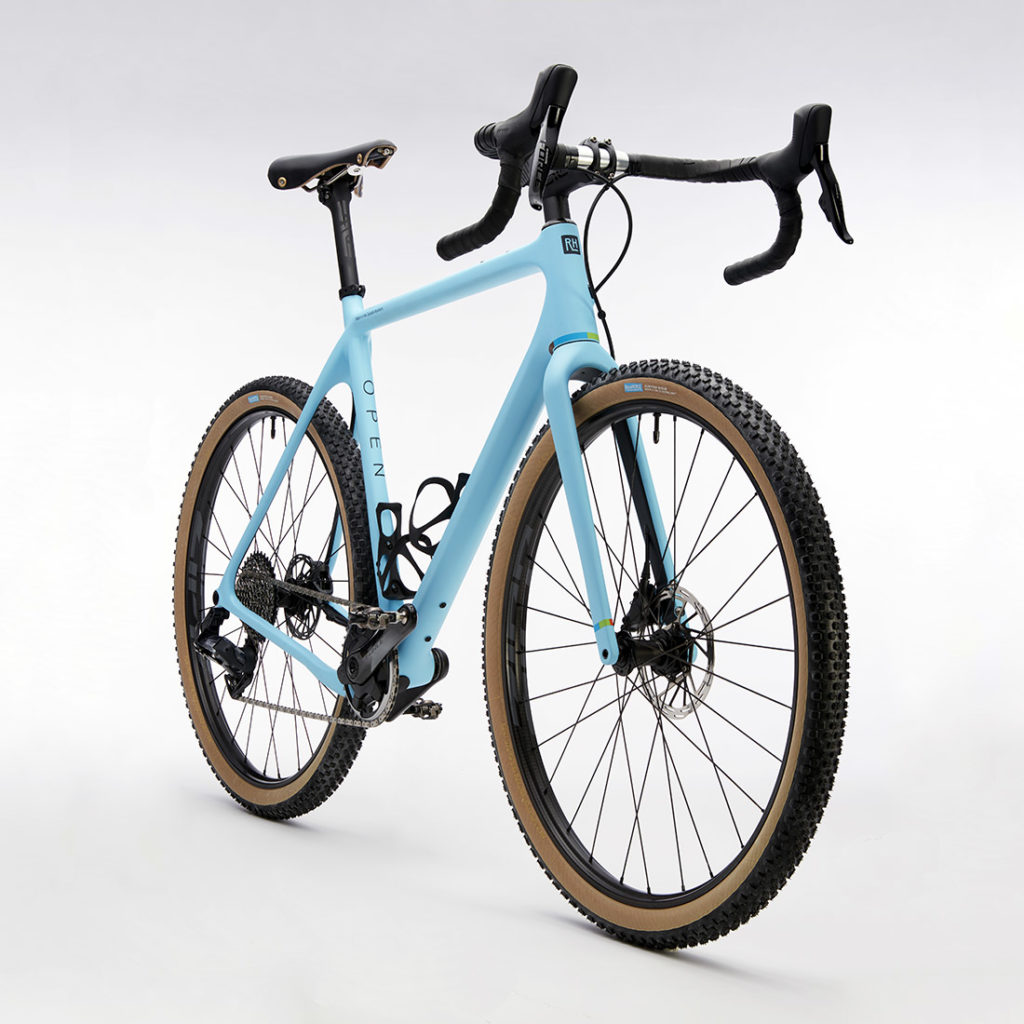
Once you add a front derailleur, you’re back to a more complex way of operating the bike: If I have to plan my front downshifts (with the associated drop of a few cogs in the rear to avoid a big drop in speed), that almost defeats the appeal of electronic shifting: not having to think about changing gears at all.
To me, the mid-level Force group represents the best compromise between value and performance in the SRAM program. According to SRAM’s engineers, the derailleurs and shifters are functionally identical to the more expensive Red. The Force carbon cranks aren’t hollow, so they weigh a bit more, but the difference isn’t huge. (The Red chainrings are also more nicely machined, but when you upgrade to the power meter, you get the Red ring.) SRAM’s Force XPLR cranks come in two versions: My U.P.P.E.R. currently runs the ‘wide’ cranks, but there’s enough clearance that the standard version should fit. (Our friends at SRAM sent us prototypes of both to get our feedback.) I have no trouble spinning the 150 mm Q factor of the ‘wide’ cranks, but I know I’ll be even happier on the ‘standard’ cranks with 146 mm between crank faces.
Why no Rene Herse cranks? Basically, metal parts make sense on metal bikes. Making a Rene Herse crank for a large-diameter spindle would add a lot of weight. (You’d need a lot of material to surround that large spindle.) Carbon is a very different material from metal: It’s much less dense, so there’s more volume for the same strength and stiffness. That’s why BB spindles became larger: Carbon cranks have more bulk, so there’s plenty of room to accommodate the large spindle. On a carbon bike, carbon cranks simply make the most sense. That said, I wish I could fine-tune my gearing as I can with Rene Herse cranks.
My bike has the optional 10-36 cassette rather than the standard 10-44, since this bike is mostly for fast-paced rides, and less for adventures on ultra-steep terrain. (We run the 10-44 on the Unbound XL Rene Herse.) Either cassette shifts great—in fact, the immediate shifts are the biggest appeal of SRAM’s new XPLR group.
In the past, the disc brakes were perhaps the only weak point in SRAM’s components: They offer great feel and modulation and plenty of power, but they need more cleaning and maintenance than I’d like. (As the calipers get dirty, they stop adjusting for pad wear, and the lever almost bottoms out on the bars when braking very hard.) I hope that issue has been resolved with the new XPLR calipers.
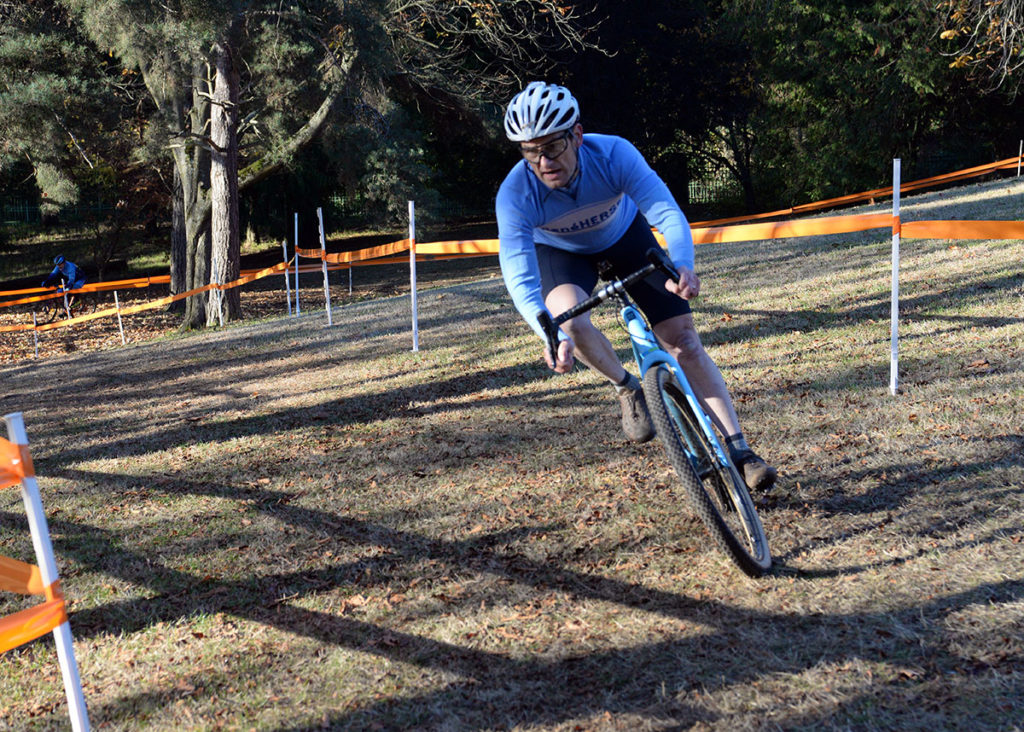
Wheels
My bike runs 650B wheels, because I want to run wide tires. For me, the appeal of the U.P.P.E.R. (and its sister, the U.P.) is that they do not accept ultra-wide 700C tires. That doesn’t make sense? Let me explain: Designed for smaller wheels, the bike is shorter, lighter and more nimble. The rotational inertia of 650B wheels and 48 mm Extralight tires is similar to 700C x 32 mm tires—for me the sweet spot of road bike handling. The wheels on this bike are ZIPP’s new XPLR wheels. The tire fit for the Rene Herse Juniper Ridge tires is just about perfect, and with the 27 mm-wide rims, the tires plump up a bit more. They measure 51 mm wide. If given a choice, I might have opted for the narrower Firecrest rims to give the tires a rounder profile, but they weren’t in stock in 650B.
Why do I run dual-purpose knobbies? It’s actually not because I want to race ‘cross on the U.P.P.E.R. (above)—although it’s nice that I can. The main reason: I wanted to see whether the knobbies have less pneumatic trail than smooth tires with a continuous tread. When we tested the U.P.P.E.R. in the past, I wished for a little more nimble handling. (Wide tires put so much rubber on the road that the steering slows down noticeably.)
It seems funny that I’m running knobbies to make the bike feel more like a road bike. Wouldn’t slick tires be faster? A recent ride confirmed once again what our carefully controlled tests have shown: Speed-wise, our dual-purpose knobbies really make no difference to our smooth tires. (They may look like other knobbies, but they perform like slick tires with the unnecessary parts of the tread removed.) I know exactly how fast I roll on flats and uphills compared to the others on the BQ Team. If the knobbies held me back, I’d notice and so would my friends. In fact, I set numerous PRs during that ride, and certainly didn’t hold my friends back, either. However, the difference in feel between knobby and smooth tires is small, and I’ll probably put on some smooth Switchback Hill 650Bx48s once the knobbies wear out. (Which won’t be for quite a few miles.)
Why Extralight casing? For me, it brings out the best in the bike. Not just speed, but also comfort, grip and traction. Not recommended for riders who tend to destroy tires, or for ultra-rough terrain, but otherwise, Extralights are hard to beat. And for most riding, they are plenty durable. Just one datapoint: The entire BQ Team has been running Extralights for many years now, and I’m the only one who’s ever cut a sidewall. (Twice, in fact! But the Oregon Outback and the Arkansas High Country Race are about as tough as conditions get. Running Extralights in terrain that really calls for Endurance casings was a calculated risk, but that’s another story.)
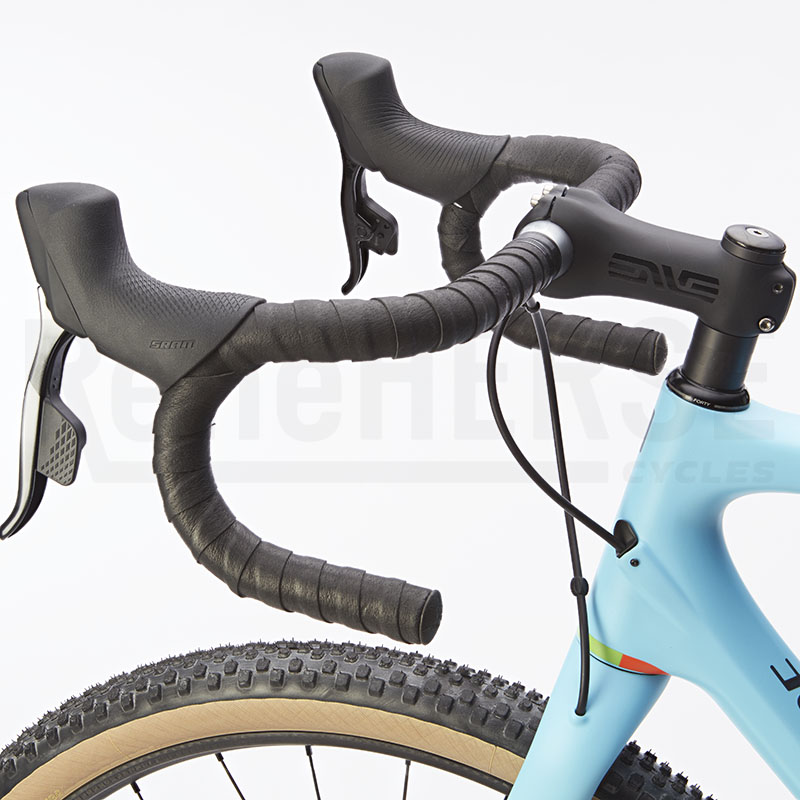
Bars, Stem, Saddle
The handlebars are Rene Herse Maes Parallel. I love the long reach and multiple hand positions—perfect for rides where the pace varies a lot: I sit more upright during quiet interludes and stretch out to make power when we go fast. Bar tape is Maware’s luscious pigskin tape. The leather feels so nice that I miss it when I ride bikes with rubbery or rough-textured tape. (I totally understand riders who prefer vegan options.)
Stem is an Enve that’s as beautiful as it is functional. Seatpost is by ZIPP: The quality is top-notch. (Few things are more frustrating than a seatpost that’s sliding because the diameter is too small.) Saddle is a Berthoud Galibier with titanium rails—the perfect balance between comfort for all-day rides and light weight to maintain that ‘road bike’ feel when rocking the bike during out-of-the-saddle efforts. The bottle cages are Enve—of all the carbon cages, they seem to hold bottles most securely. And they are beautiful, too. Pedals are my favorites—Shimano XTR are so smooth to click in and out. To me, they are worth the substantial cost.
Weight, etc.
Fully equipped, my U.P.P.E.R. tips the scales at 8.5 kg (18.7 lb). That weight includes pedals, bottle cages and the comfortable saddle. The bike could be lightened with super-trick parts, but at the expense of durability. I want this to be a bike I can just jump on and ride. The SRAM eTap electronic shifting has a battery that unclips. I have two batteries, so one is always fully charged, and when in doubt, I just replace the battery before the start of a ride. That takes the hassle out of running a bike with electronic shifting.
I love riding my new bike. To me, it brings out the best in modern cycling technology: One-by and electronic derailleurs make shifting totally intuitive. The wide tires allow me to go almost anywhere. The carbon frame feels subtly different from my steel bikes, in a good way. On one level, riding the U.P.P.E.R. is a very different experience from my steel Rene Herse: The U.P.P.E.R. is digital; the Herse is analog. And yet both feel remarkably similar: Both bikes become extensions of my body that don’t require active thought to operate. Both are equally fast and equally exhilarating to ride. They really make a perfect pair. (Sorry, no pictures side-by-side of the two yet, so below are two steel Rene Herses with Mark and me.)
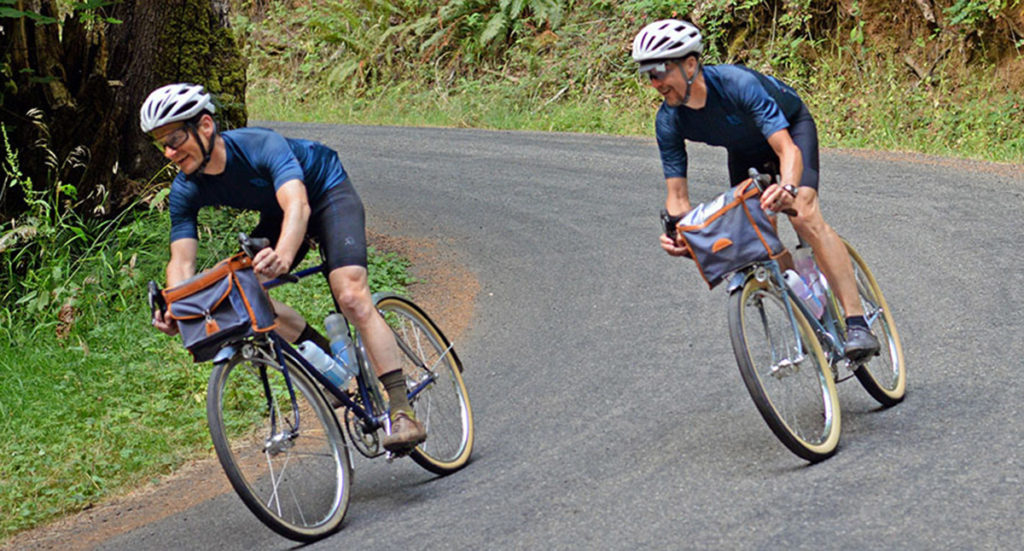
Beyond the difference in feel between these two types of bikes, there’s the big question of reliability. Our steel rando bikes are such mature designs that they are utterly reliable. Mark’s 6-Hands has seen 15 years (!) of regular, hard riding—more than 60,000 miles (100,000 km)—with only a few replacement parts. My first Rene Herse has reached about 2/3 of that distance, with just a few changes of chains, brake pads and tires.
It’s probably unrealistic to expect that kind of mileage from modern mainstream components, but electronic shifting promises to be more reliable than the tiny ratchets and long cable housings of mechanical brifters. Once I have more miles on the U.P.P.E.R., I’ll report in Bicycle Quarterly how the parts are holding up. Those miles will accumulate quickly: I can’t wait for the weather to turn dry, so I can take my new bike out again.
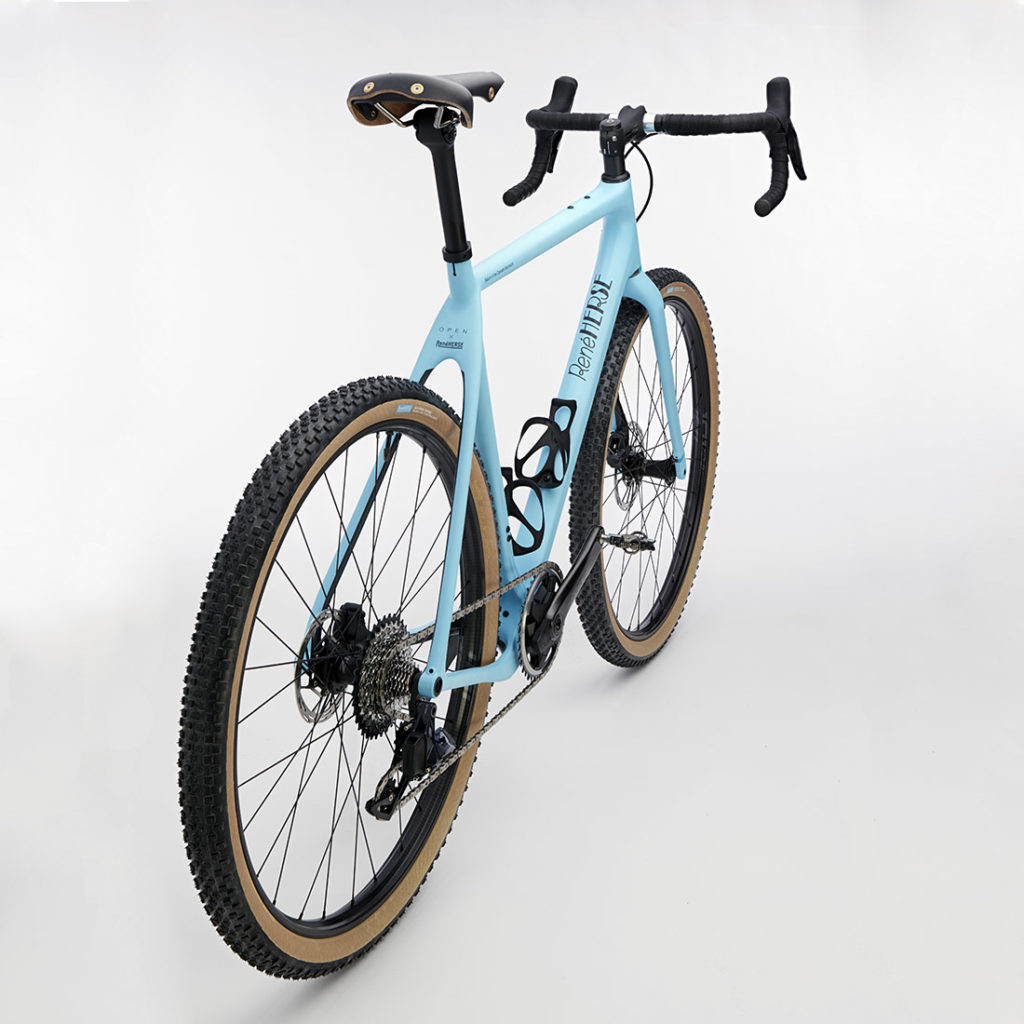
For readers who want to know all the details, here’s the parts list:
- Frame/Fork: OPEN × Rene Herse U.P.P.E.R., size L
- Headset: Cane Creek (included with frameset)
- Rear derailleur: SRAM RD-FRC1-E-D1 FORCE XPLR ETAP AXS REAR DERAILLEUR
- Shifters/Brakes: SRAM ED-FRC-D1 FORCE ETAP AXS HRD SHIFT-BRAKE SYSTEM
- Cassette: SRAM CS-XG-1270-D1 FORCE XG-1270 CASSETTE 10-36
- Chain: SRAM CN-FRC-D1 FORCE CHAIN
- Wheels: ZIPP 101 XPLR 650B TUBELESS DISC-BRAKE
- Tires: Rene Herse 650B x 48 Juniper Ridge Extralight
- Disc Rotors: SRAM 160 mm (front) and 140 mm (rear)
- Bottom Bracket: SRAM BB386EVO
- Cranks: SRAM Force XPLR with Power Meter, 172.5 mm
- Pedals: Shimano M9100 XTR, short spindle
- Seatpost: ZIPP SP-SL-S-B2, 27.2 mm, 0 offset
- Saddle: Berthoud Galibier, black
- Stem: ENVE Road Carbon Stem, 100 mm
- Handlebars: Rene Herse Maes Parallel 31.8, 440 mm wide
- Bar Tape: Maware leather, black
- Bottle Cages: Enve


